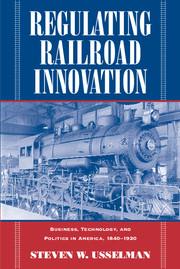Book contents
- Frontmatter
- Contents
- List of Illustrations
- Preface and Acknowledgments
- Introduction
- Part I ASSEMBLING THE MACHINE, 1840–1876
- 1 Engines of Expansion and Extraction: The Politics of Development
- 2 Acquiring Technology: Insider Innovation
- 3 Patent Problems: Inventors and the Market for Technology
- Part II RUNNING THE MACHINE, 1876–1904
- Part III FRICTION IN THE MACHINE, 1904–1920
- Epilogue: The Enduring Challenge of Innovation
- Index
2 - Acquiring Technology: Insider Innovation
from Part I - ASSEMBLING THE MACHINE, 1840–1876
Published online by Cambridge University Press: 12 August 2009
- Frontmatter
- Contents
- List of Illustrations
- Preface and Acknowledgments
- Introduction
- Part I ASSEMBLING THE MACHINE, 1840–1876
- 1 Engines of Expansion and Extraction: The Politics of Development
- 2 Acquiring Technology: Insider Innovation
- 3 Patent Problems: Inventors and the Market for Technology
- Part II RUNNING THE MACHINE, 1876–1904
- Part III FRICTION IN THE MACHINE, 1904–1920
- Epilogue: The Enduring Challenge of Innovation
- Index
Summary
Throughout this tumultuous developmental period, American railroads possessed little of the ordered, systematic character that would later become their hallmark. The early lines were essentially grand experiments. Their founders took a new, European invention – the combination of steam locomotive, fixed rails, and a train of carriages or wagons – and scrambled to adapt it to different sets of conditions. Short on capital and labor, with long stretches of sparsely settled territory to cross and a comparatively weak industrial base on which to draw, these early builders constructed serviceable prototypes of what would eventually emerge as a distinctly American style of railroad. Though railroads stood out in the context of the American economy as highly capitalized institutions of great technical complexity, in comparison to railroads in other countries they appeared shoddy and underbuilt (Fig. 2.1). To European eyes, the American lines were primitive affairs, built quickly and cheaply and operated with insufficient care. A delegation of European technicians who visited the United States on the eve of the New York Crystal Palace Exhibition of 1853 gave the railroads little more than a passing mention in their reports. Though the Civil War pumped new resources into railroading and imparted a new emphasis in some quarters on handling traffic efficiently, the conflict in many ways accentuated the slipshod character of the industry.
- Type
- Chapter
- Information
- Regulating Railroad InnovationBusiness, Technology, and Politics in America, 1840–1920, pp. 61 - 96Publisher: Cambridge University PressPrint publication year: 2002



